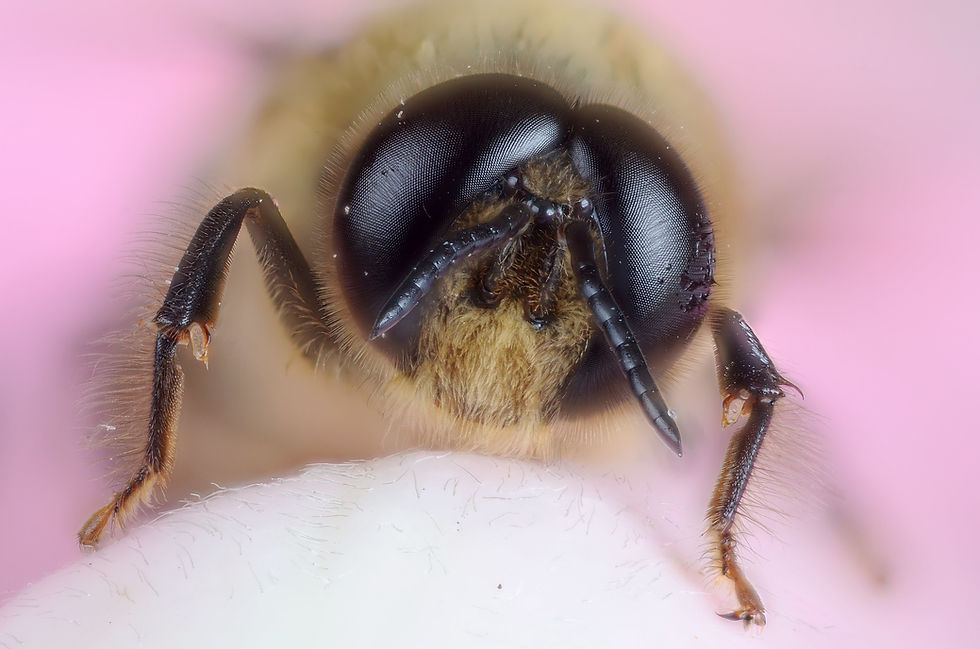The honeybee worker - simply the best!
- Harry

- Mar 31, 2021
- 3 min read
Updated: Mar 31, 2023
Although the queen gets all the PR, the worker is the real star of the honeybee show.

We often attend fairs and shows. We always take our observation hive so people can see the inner workings of a honeybee colony. Of all the thousands of bees, it's always the queen that people want to see. Everyone loves the thought of the queen and she is very important. But, she only has one job - to lay eggs. Honeybee workers do absolutely everything else. Without her industrious daughters, the queen would last about an hour. No workers, no colony.
Humans live in a 50/50 world of male and female so it's sometimes easy to forget that all the honeybees we see in our gardens are female
At its summer peak, a colony may have more than 60,000 bees - apart from 1 queen and say, 2,000 drones (males) all of these will be female workers. Each lives for no more than about 40 days. In a miracle of evolutionary organisation that humans have yet to fathom, every worker bee does certain jobs in a set order. For the first half of their lives they work inside the hive. At this stage beekeepers call them "house bees".
Their first job is to clean out the hive's cells. These are where the queen lays her eggs - 1 egg to 1 cell. They make up the honeycomb that is so familiar to us but cells are also used to hold the eggs that will grow into new bees. Each time a new bee emerges, her worker sisters clean out the little cubicle ready for the queen to lay another egg.
The next job is looking after the developing eggs and larvae. This is called brood rearing. It's a big job! The queen may be laying 1,500 eggs a day. Each needs to be tended until a larva emerges from the egg. Then, the worker bees feed the larvae, using a mixture of fats and proteins produced from special glands (the hypopharyngeal gland and the mandibular gland) in the worker bee's head. They do this job for a few days or so before moving on to feeding the queen. The queen doesn't feed or groom herself. She depends on her daughters completely.
As the days go by, and other glands develop, the house bees stop brood rearing and go to what we might call "goods inwards". They receive pollen and nectar from the returning foragers. They take it and pack it for future use. In the case of nectar they may process it into honey. The queen lays her eggs in the centre of the colony; the house bees store pollen and nectar in a ring around these eggs - so they are in easy reach for the next generation of house bees who need to eat pollen ready for brood rearing. Their last job inside the hive is comb making. Honeybees don't recycle comb. They make it fresh as they need it, from specially developed wax glands on their abdomens. Using the wax they make, house bees build the comb for more egg laying or storing pollen/nectar/honey.
The worker bees are now about half-way through their short lives. These are "middle-aged bees" and they are an important pool of labour for the hive. As they get older they will go on to work outside the hive. But if they are needed, they can "go back" and do the jobs of younger bees.
All things being equal, their next job is to help keep the hive cool. Honeybees maintain their hive at about 34C. If the temperature begins to rise, workers will go to the hive entrance and start to fan their wings. If it gets really hot, they'll line up to create a funnel effect that draws fresh cool air into the hive. They also do guard duty. Standing at the front of the hive they'll check that incoming bees are sisters rather than robbers. If robbing bees or wasps try and get in, the worker bees are ready to defend their home. It's not always successful but they will fight to the death for their hive.
Their last job is foraging. This is when humans notice them - flying from flower to flower carrying loads of pollen or nectar back to the hive. The colony needs vast quantities of energy and protein to grow. As the year rolls on, the need to gather stores for the winter takes over. Foraging bees will work until they are worn out by working for their queen and their sisters.
So, next time the queen gets all the glory, remember the worker bee - she's the one that keeps the show on the road, fruit on the trees and honey on the table!
The fab picture of a bee on a plum flower is courtesy of Gilles San Martin (on Flickr) and via a Creative Commons Licence



Comments